医学PPT课件:糖尿病(英文版)
合集下载
Diabetes糖尿病英文PPT学习课件
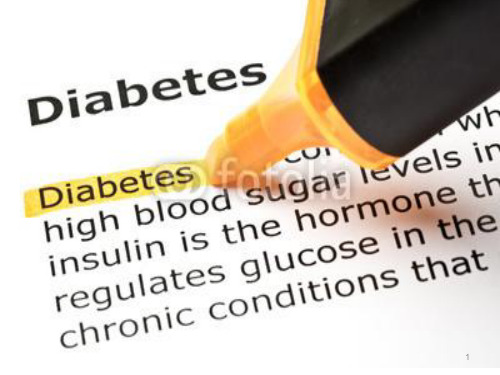
thyroid/o
thyroid 甲状腺
thyroiditis thyroidectomy hypothyroidism
ovari/o
ovary 卵巢
ovariotomy ovaritis ovariopathy
-trophic
nutrition,growth, neurotrophic nourishment thymotrophic 营养(的) adrenotrophic
meaning
内胚层 内镜 内质
甲状腺炎 甲状腺切除术 甲状腺功能减退
卵巢切开术 卵巢炎 卵巢病
神经营养性的 促胸腺的 促肾上腺的
2019/11/2
44
contents
01 Brief Introduction 02 Classification 03 The major factors 04 Pathogenesis 05 Clinical Manifestations 06 Complications 07 Diagnosis 08 Antidiastole 09 Therapy
肾上腺炎 抗肾上腺素的 肾上腺病
2019/11/2
22
Terminology
Combining form meaning prefix and suffix
pancreat/o
pancreas 胰腺
gluc/o
sugar 糖
glyc/o
sugar 糖
insulin/o
insulin 胰岛素
terminology
6
02 Classification
2.1 Type 1 diabetes
The pancreas undergoes an autoimmune attack by the body itself,and is rendered incapable of making insulin.Abnormal antibodies have been found in the majority of patients with type1 diabetes.Antibodies are proteins in the blood that are part of the body‘s immune system,the patient with type1 diabetes must rely on insulin medication for survival.
糖尿病基础知识英文课件

CHAPTER 03
Diagnosis and treatment of diabetes
Diagnostic criteria for diabetes
Random (casual) blood glucose level
A blood glucose level of 200 mg/dL (11.1 mmol/L) or higher with symptoms of diabetes such as increased thirst, frequent urination, and unexplained weight loss also indicates diabetes.
Insulin Deficiency or Resistance
In Type 1 diabetes, there is a significant reduction in insulin production by the pancreas, while in Type 2 diabetes, the body's cells become resistant to insulin, leading to inadequate glucose uptake and utilization.
An HbA1c of 6.5% or higher indicates diabetes. This test measures the average blood glucose level over the past 2-3 months.
Treatment of diabetes
01 02 03
Comorbidities and complications
Diabetes can lead to various serious health complications, including cardiovascular diseases, stroke, kidney failure, blindness, nerve damage, and amputations.
糖尿病全英文课件(医学课件)

Type 2 DM
遗传易感性、环境因素(如饮食、缺乏运动等)导致胰岛素抵抗和分泌不足。
发病机制
临床表现
多饮、多尿、多食、体重减轻等典型症状。长期高血糖可引起视物模糊、肾病、神经病变、心血管疾病等。
诊断标准
空腹血糖≥7.0 mmol/L,或餐后2小时血糖≥11.1 mmol/L,或随机血糖≥11.1 mmol/L,同时伴有尿糖阳性。
提高公众对糖尿病的认识和重视程度,促进早期筛查和预防。
THANK YOU.
谢谢您的观看
糖尿病患者应积极参与健康管理,掌握自身病情进展情况,及时调整治疗方案。
05
糖尿病患者教育及心理疏导
患者教育的内容
了解糖尿病的病因、诊断、治疗方法、并发症的预防等知识,培养患者健康的生活方式。
患者教育的目标
提高患者对于糖尿病的认识,培养患者自我管理能力,提高生活质量。
患者教育的形式
包括集体授课、小组讨论、案例分析、示范教育等。
临床表现与诊断标准
02
糖尿病的危害与并发症
急性并发症
Hyperglycemia
高血糖,可能导致脱水、电解质失衡、肾功能受损
Hypoglycemia
低血糖,可能导致脑损伤、昏迷、甚至死亡
Ketoacidosis
酮症酸中毒,一种严重的代谢紊乱,导致脱水、电解质失衡、酸中毒
01
02
03
慢性并发症
三级预防
强化治疗
糖尿病患者应积极参与健康管理,包括定期检查、合理饮食、适当运动等,以维持身体健康。
健康管理
糖尿病是一种慢性疾病,对患者心理和生活质量都有一定影响,因此应给予患者必要的心理支持和帮助。
心理支持
健康管理的重要性
遗传易感性、环境因素(如饮食、缺乏运动等)导致胰岛素抵抗和分泌不足。
发病机制
临床表现
多饮、多尿、多食、体重减轻等典型症状。长期高血糖可引起视物模糊、肾病、神经病变、心血管疾病等。
诊断标准
空腹血糖≥7.0 mmol/L,或餐后2小时血糖≥11.1 mmol/L,或随机血糖≥11.1 mmol/L,同时伴有尿糖阳性。
提高公众对糖尿病的认识和重视程度,促进早期筛查和预防。
THANK YOU.
谢谢您的观看
糖尿病患者应积极参与健康管理,掌握自身病情进展情况,及时调整治疗方案。
05
糖尿病患者教育及心理疏导
患者教育的内容
了解糖尿病的病因、诊断、治疗方法、并发症的预防等知识,培养患者健康的生活方式。
患者教育的目标
提高患者对于糖尿病的认识,培养患者自我管理能力,提高生活质量。
患者教育的形式
包括集体授课、小组讨论、案例分析、示范教育等。
临床表现与诊断标准
02
糖尿病的危害与并发症
急性并发症
Hyperglycemia
高血糖,可能导致脱水、电解质失衡、肾功能受损
Hypoglycemia
低血糖,可能导致脑损伤、昏迷、甚至死亡
Ketoacidosis
酮症酸中毒,一种严重的代谢紊乱,导致脱水、电解质失衡、酸中毒
01
02
03
慢性并发症
三级预防
强化治疗
糖尿病患者应积极参与健康管理,包括定期检查、合理饮食、适当运动等,以维持身体健康。
健康管理
糖尿病是一种慢性疾病,对患者心理和生活质量都有一定影响,因此应给予患者必要的心理支持和帮助。
心理支持
健康管理的重要性
糖尿病全英文课件(共23张PPT)可编辑全文

foot disease
infection
retinopathy
nephropathy
neuropathy
Sensory neuropathy
Autonomic neuropathy
Motor neuropathy
Gastroparesis
Bladder neuropathy
Diarrhea or Constipation
Ⅱ、Signs and symptoms Oral Medications
[stimulating the pancreas produce more insulin ]
oral glucose ≥11.1
tolerance test ≥ 7.8 and <11.1
<7.8
diagnose
diabetes
Gestational diabetes absence of insulin
Use of alcohol
Sulfonylureas Biguanides being a member of a high-risk group
Other types
Types
Ⅰ、Definition and Types Ⅱ、Signs and symptoms
1 accompanied with symptoms Sulfonylureas complications Differences between type1 and type2
Ⅱ、Signs and symptoms Sulfonylureas
Thiazolidinediones insufficient insulin Ⅱ、Signs and symptoms life depends on insulin.
糖尿病 Diabetes 英语ppt
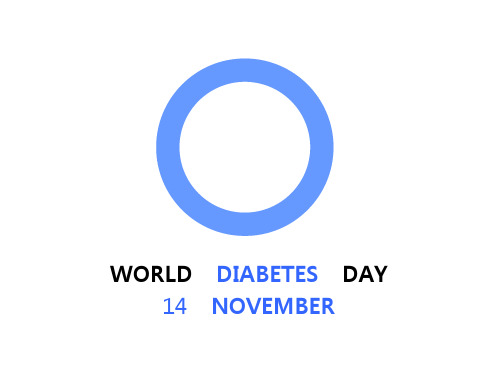
There are 3 main types of DM
• Type 1 DM (Ⅰ型糖尿病) • Type 2 DM (Ⅱ型糖尿病) • Gestational diabetes(妊娠糖尿病)
Although each type of diabetes symptoms (症状) are similar or the same, but the causes and their distribution in different the crowd(在人群中的分布) was different.
Anyway
Eat fewer snacks Eat more vegetables Sleep enouup 5
1.Lifestyle:diet, exercise,smoking 2.Medication:anti-diabetic medication 3.Insulin therapy(胰岛素治疗)
Suggestion
In our daily lives,we should
• eat the cereal food(谷物食物) and aviod having too much fat • never keeping seated for too long,and doing some sports everyday • have enough sleep • have a physical examination regularly (It can help us find out our healthy problems earlier so that we won‘t miss the best chance to heal them.)
Symptom
• • • • frequent urination尿频 increased thirst口渴 increased hunger饥饿 lose weight消瘦
• Type 1 DM (Ⅰ型糖尿病) • Type 2 DM (Ⅱ型糖尿病) • Gestational diabetes(妊娠糖尿病)
Although each type of diabetes symptoms (症状) are similar or the same, but the causes and their distribution in different the crowd(在人群中的分布) was different.
Anyway
Eat fewer snacks Eat more vegetables Sleep enouup 5
1.Lifestyle:diet, exercise,smoking 2.Medication:anti-diabetic medication 3.Insulin therapy(胰岛素治疗)
Suggestion
In our daily lives,we should
• eat the cereal food(谷物食物) and aviod having too much fat • never keeping seated for too long,and doing some sports everyday • have enough sleep • have a physical examination regularly (It can help us find out our healthy problems earlier so that we won‘t miss the best chance to heal them.)
Symptom
• • • • frequent urination尿频 increased thirst口渴 increased hunger饥饿 lose weight消瘦
糖尿病诊断及治疗英文版护理课件

Diabetic patients should increase their intake of fiber rich foods, such as vegetables, fruits, and whole grains, to help
control blood glucose levels
Exercise therapy
• Fasting blood glucose (FBG) test: patients fast overnight and blood glucose levels are measured in the morning before breakfast
• Random blood glucose test: Blood glucose levels are measured at any time of the day when symptoms are present
Other treatment methods
Psychological counseling
Diabetic patients may experience anxiety and depression due to the chronic nature of the disease Psychological counseling can help them better scope with the disease
• Self monitoring of blood glucose (SMBG): patients measure their own blood glucose levels at regular intervals throughout the day using blood glucose meters
control blood glucose levels
Exercise therapy
• Fasting blood glucose (FBG) test: patients fast overnight and blood glucose levels are measured in the morning before breakfast
• Random blood glucose test: Blood glucose levels are measured at any time of the day when symptoms are present
Other treatment methods
Psychological counseling
Diabetic patients may experience anxiety and depression due to the chronic nature of the disease Psychological counseling can help them better scope with the disease
• Self monitoring of blood glucose (SMBG): patients measure their own blood glucose levels at regular intervals throughout the day using blood glucose meters
糖尿病全英文课件24页
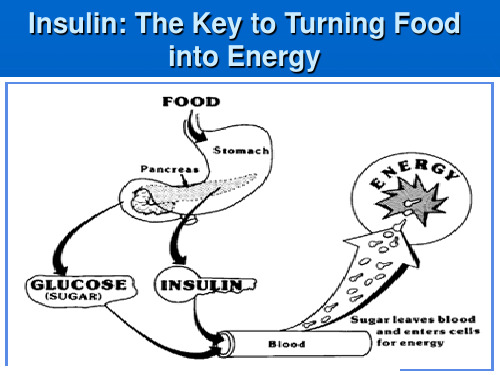
over 4 kg birth, or have had gestational diabetes having high cholesterol or other fats in the blood
having hypertension or heart disease
Ⅱ、Signs and symptoms
radom
≥11.1 accompanied with symptoms
Fasting
≥ 7.0
≥6.1 and<7.0
<6.0
Insulin: The Key to Turning Food into Energy
Ⅰ、Definition and Types Ⅱ、Signs and symptoms Ⅲ、Diagnosis and Treatment
Definition
Type 1 diabetes Type 2 diabetes Gestational diabetes Other types
usually before 40 if after 40 usually slow onset
often thin
usually after 40, although increasing in younger people
often overweight, especially apple figure
Ⅱ、Signs and symptoms
Differences between type1 and type2
feature
Type 1
Type 2
Insulin production Age at onset
Physical appearance Symptoms
having hypertension or heart disease
Ⅱ、Signs and symptoms
radom
≥11.1 accompanied with symptoms
Fasting
≥ 7.0
≥6.1 and<7.0
<6.0
Insulin: The Key to Turning Food into Energy
Ⅰ、Definition and Types Ⅱ、Signs and symptoms Ⅲ、Diagnosis and Treatment
Definition
Type 1 diabetes Type 2 diabetes Gestational diabetes Other types
usually before 40 if after 40 usually slow onset
often thin
usually after 40, although increasing in younger people
often overweight, especially apple figure
Ⅱ、Signs and symptoms
Differences between type1 and type2
feature
Type 1
Type 2
Insulin production Age at onset
Physical appearance Symptoms
英文糖尿病PPT课件
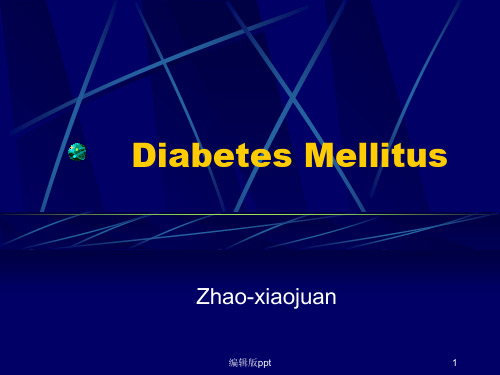
II.Type 2diabetes ( may range from predominantly insulin resistance with relative insulin deficiency to a predominantly secretory defect with insulin resistance )
Ranging from predominantly insulin resistance with relative insulin deficiency to predominantly an insulin secretory defect with insulin resistance
Classification (2)
Gestational diabetes mellitus(GDM)
diagnosed during pregnancy
Etiologic classification of diabetes mellitus(1)
I.Type 1diabetes ( -cell destruction, usually leading to absolute insulin deficiency ) A. immune mediated B. Idiopathic
Other specific types of diabetes
Due to other causes, e.g.,genetic defects in insulin action, diseases of the exocrine pancreas, drug or chemical induced
III.Other specific types A. genetic defects of -cell function 1. Chromosome 12, HNF-1 (MODY3) 2. Chromosome 7, glucokinase (MODY2) 3. Chromosome 20, HNF-4 (MODY1) 4. Mitochondrial DNA 5. Others B. Genetic defects in insulin action 1. Type A insulin resistance 2. Leprechaunism 3. Rabson- Mendenhall syndrome 4. Lipoatrophic disease 5. Others C. Diseases of the exocrine pancreas 1. Pancreatitis 2. Trauma / pancreatectomy 3. Neoplasia 4. Cystic fibrosis 5. Hemochromatosis 6. Fibrocalculous pancreatopathy 7. Others
Ranging from predominantly insulin resistance with relative insulin deficiency to predominantly an insulin secretory defect with insulin resistance
Classification (2)
Gestational diabetes mellitus(GDM)
diagnosed during pregnancy
Etiologic classification of diabetes mellitus(1)
I.Type 1diabetes ( -cell destruction, usually leading to absolute insulin deficiency ) A. immune mediated B. Idiopathic
Other specific types of diabetes
Due to other causes, e.g.,genetic defects in insulin action, diseases of the exocrine pancreas, drug or chemical induced
III.Other specific types A. genetic defects of -cell function 1. Chromosome 12, HNF-1 (MODY3) 2. Chromosome 7, glucokinase (MODY2) 3. Chromosome 20, HNF-4 (MODY1) 4. Mitochondrial DNA 5. Others B. Genetic defects in insulin action 1. Type A insulin resistance 2. Leprechaunism 3. Rabson- Mendenhall syndrome 4. Lipoatrophic disease 5. Others C. Diseases of the exocrine pancreas 1. Pancreatitis 2. Trauma / pancreatectomy 3. Neoplasia 4. Cystic fibrosis 5. Hemochromatosis 6. Fibrocalculous pancreatopathy 7. Others
糖尿病(全英文版)DiabetesMellitusppt课件
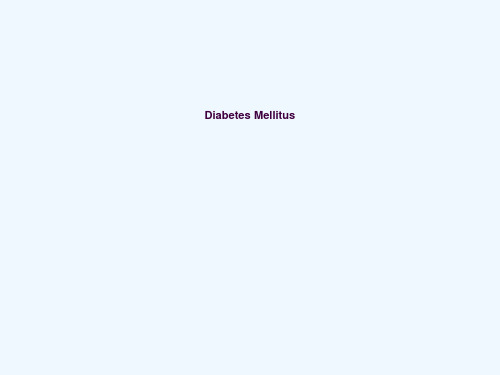
Diabetes Mellitus
Teaching objectives
▪ grasp the definition and types of diabetes mellitus ▪ realize etiology and pathogenesis ▪ realize diagnosis and classification ▪ grasp the clinical manifestation for the patient with diabetes mellitus ▪ be aware of the main lab examination ▪ realize the treatment for the patient with diabetes mellitus
diabetic foot infection: gangrenous
urine glucose blood glucose IGT
Lab test
Treatment
Diet maintain as near-normal blood glucose level as possible, achieve optimal serum lipid levels, provide adequate energy.
▪ Factors associated with diabetes include obesity, aging, and ethnic group.
Classification
Type 1 diabetes Stage 1: genetics emotivity Stage 2: start autoimmune Stage 3: immunology abnormality
Acute complications of diabetes: DKA, hyperosmolar nonketotic diabetic coma, infection
Teaching objectives
▪ grasp the definition and types of diabetes mellitus ▪ realize etiology and pathogenesis ▪ realize diagnosis and classification ▪ grasp the clinical manifestation for the patient with diabetes mellitus ▪ be aware of the main lab examination ▪ realize the treatment for the patient with diabetes mellitus
diabetic foot infection: gangrenous
urine glucose blood glucose IGT
Lab test
Treatment
Diet maintain as near-normal blood glucose level as possible, achieve optimal serum lipid levels, provide adequate energy.
▪ Factors associated with diabetes include obesity, aging, and ethnic group.
Classification
Type 1 diabetes Stage 1: genetics emotivity Stage 2: start autoimmune Stage 3: immunology abnormality
Acute complications of diabetes: DKA, hyperosmolar nonketotic diabetic coma, infection
英文糖尿病PPT课件
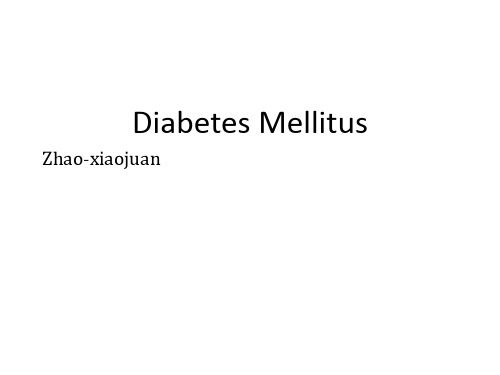
Type 2 DM
Generally >40 years Slowly onset Not severe symptoms Obesity Ketoacidosis seldom occur Nonketotic hyperosmolar syndrome Normal or elevated C-peptide levels Genetic predisposition
Etiologic classification of diabetes mellitus(2)
D. Endocrinopathies 1. Acromegaly 2. Cushing’s syndrome 3. Glucagonoma 4. Pheochromocytoma 5. Hyperthyroidism 6. Somatostatinoma 7. Aldosteronoma 8. Others
Pathophysiological model for development of obesity and T2DM
Beta-cell defect
Glucose toxicity
Intra-uterin growth
retardation Insulin
Resistance genes
Obesity genes
IV. Gestational diabetes mellitus ( GDM )
Patients with any form of diabetes may require insulin treatment at some stage of their disease. Such use of insulin dose not, of itself, classify the patient.
糖尿病全英文课件(医学PPT课件)
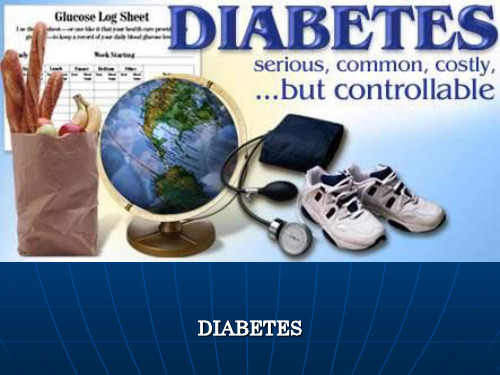
Diabetes in Adults )
Ⅱ、Signs and symptoms
About Type 2 diabetes
insufficient insulin Insulin resistance/hyperinsulinemia X Syndrome
insulin resistance hyperlipidimia hypertension obesity(apple figure) coronary heart disease
over 4 kg birth, or have had gestational diabetes having high cholesterol or other fats in the blood having hypertension or heart disease
Ⅱ、Signs and symptoms
Types
Ⅰ、Definition and Types Ⅱ、Signs and symptoms Ⅲ、Diagnosis and Treatment
Risk factors for developing diabetes
being age 45 or over being overweight being a member of a high-risk group having close relatives with diabetes having given birth to a baby that weighed
foot disease
infection
retinopathy
nephropathy
neuropathy
Sensory neuropathy
Ⅱ、Signs and symptoms
About Type 2 diabetes
insufficient insulin Insulin resistance/hyperinsulinemia X Syndrome
insulin resistance hyperlipidimia hypertension obesity(apple figure) coronary heart disease
over 4 kg birth, or have had gestational diabetes having high cholesterol or other fats in the blood having hypertension or heart disease
Ⅱ、Signs and symptoms
Types
Ⅰ、Definition and Types Ⅱ、Signs and symptoms Ⅲ、Diagnosis and Treatment
Risk factors for developing diabetes
being age 45 or over being overweight being a member of a high-risk group having close relatives with diabetes having given birth to a baby that weighed
foot disease
infection
retinopathy
nephropathy
neuropathy
Sensory neuropathy
医学课件:糖尿病(英文版)

慢性并发症
01
Microvascular co…
微血管并发症是糖尿病的慢性并发症 之一,包括视网膜病变、糖尿病肾病 和糖尿病神经病变。
02
Macrovascular co…
大血管并发症包括冠心病、脑卒中、 下肢动脉硬化等,是糖尿病患者的主 要死亡原因。
03
Dyslipidemia
血脂异常是糖尿病患者的常见并发症 ,可导致动脉粥样硬化和心血管疾病 风险增加。
类型2糖尿病的病因
遗传因素
类型2糖尿病的发生与遗传有关,家族中有患病史的人群患病风险较高。
环境因素
环境因素是类型2糖尿病发病的重要诱因,主要包括缺乏运动、饮食不合理、 肥胖、吸烟、饮酒等。
妊娠期糖尿病的病因
遗传因素
妊娠期糖尿病与遗传有关,家族中有糖尿病史的女性患病风险较高。
环境因素
妊娠期糖尿病的发生还与多种环境因素有关,如孕期饮食不合理、缺乏运动、肥 胖、妊娠期年龄过大等。
03
糖尿病的诊断
糖尿病的筛查
常规筛查
对年龄、体重、家族史等高危人群应定期进行血 糖检测。
症状筛查
如多饮、多尿、多食、体重下降等,可疑为糖尿 病症状。
随机筛查
对无高危因素和无症状的人群,可进行随机血糖 检测。
糖尿病的诊断标准
空腹血糖(FPG):≥7.0 mmol/L
OGTT(口服葡萄糖耐量试验):2小时血糖≥11.1 mmol/L
多吃富含膳食纤维的食物,如蔬菜、水果等 。
糖尿病的运动治疗
有氧运动
如快走、慢跑、游泳等,可改善心肺功能 。
伸展运动
如瑜伽、太极等,可增加身体柔韧性。
抗阻运动
如举重、俯卧撑等,可增强肌肉力量。
医学课件:糖尿病(英文版)

技能培训
为患者提供技能培训,如如何使用 胰岛素、血糖监测等。
营养教育
为患者提供营养教育,指导他们如 何合理安排饮食,控制血糖和体重 。
05
糖尿病的案例分析
案例一:青少年糖尿病
总结词: 不良的生活习惯、遗传因素、免疫系统问题以 及病毒感染都可能导致青少年糖尿病。
1. 不良的生活习惯:如不规律的饮食、缺乏运动等都可 能影响胰岛素的正常工作,导致糖尿病。
案例三:妊娠期糖尿病
详细描述
2. 对胎儿的影响:妊娠期糖尿病 可能导致胎儿出现出生时低血糖 、黄疸、呼吸窘迫综合征等并发 症。
总结词: 妊娠期糖尿病指在怀孕期 间出现的糖尿病,可能对母亲和 胎儿的健康产生严重影响。
1. 对母亲的影响:妊娠期糖尿病 可能导致孕妇出现高血压、先兆 子痫、感染等并发症。
糖尿病的药物治疗
口服降糖药
包括胰岛素促泌剂、双胍类、糖苷 酶抑制剂等,适用于不同类型和程 度的糖尿病患者。
胰岛素
适用于1型糖尿病和2型糖尿病的晚 期患者,有短效、中效、长效等多 种类型。
其他药物
如GLP-1受体激动剂、DPP-4抑制 剂等,可用于肥胖或超重糖尿病患 者。
注意
以上内容仅供参考,具体治疗方案 请根据医生建议制定。
2023
医学课件:糖尿病(英文版)
目录
• 糖尿病概述 • 糖尿病的病因 • 糖尿病的诊断与治疗 • 糖尿病的预防与控制 • 糖尿病的案例分析 • 总结与展望
01
糖尿病概述
糖尿病的定义
Diabetes Mellitus (DM): A metabolic disease characterized by chronic hyperglycemia resulting from defects in insulin secretion, insulin action, or both.
糖尿病英文课件

A condition in which the body benefits exist to insulin or cannot produce enough insulin, often associated with obesity and aging
Type 2 diabetes
Developments during pregnancy and commonly resolved after delivery but may increase the risk of developing diabetes later in life
Gestational diabetes
Types of diamonds
Weight loss
Despit increased hunger, individuals with diamonds may experience weight loss due to increased urine output and altered metabolism
Environmental factor
Lifestyle factors refer to an individual's lifestyle habits, including diet, exercise, and daily routine.
Lifestyle factors
03
Diagnosis and treatment of diamonds
Genetic testing
Screen for diamonds and prediabetes at an early stage through regular physical examination
Type 2 diabetes
Developments during pregnancy and commonly resolved after delivery but may increase the risk of developing diabetes later in life
Gestational diabetes
Types of diamonds
Weight loss
Despit increased hunger, individuals with diamonds may experience weight loss due to increased urine output and altered metabolism
Environmental factor
Lifestyle factors refer to an individual's lifestyle habits, including diet, exercise, and daily routine.
Lifestyle factors
03
Diagnosis and treatment of diamonds
Genetic testing
Screen for diamonds and prediabetes at an early stage through regular physical examination
- 1、下载文档前请自行甄别文档内容的完整性,平台不提供额外的编辑、内容补充、找答案等附加服务。
- 2、"仅部分预览"的文档,不可在线预览部分如存在完整性等问题,可反馈申请退款(可完整预览的文档不适用该条件!)。
- 3、如文档侵犯您的权益,请联系客服反馈,我们会尽快为您处理(人工客服工作时间:9:00-18:30)。
environmental factors.ຫໍສະໝຸດ Type 2 diabetes
• Previously called non-insulin-dependent diabetes mellitus (NIDDM) or adult-onset diabetes. • Type 2 diabetes may account for about 90% to 95% of all diagnosed cases of diabetes. • It usually begins as insulin resistance, a disorder in which the cells do not use insulin
❖LADA (Latent Autoimmune Diabetes in Adults ) ❖MODY (maturity-onset diabetes of youth)
❖Secondary Diabetes Mellitus
Type 1 diabetes
• Previously called insulin-dependent diabetes mellitus (IDDM) or juvenile-onset
• The term diabetes mellitus describes a metabolic disorder of
multiple aetiology characterized by chronic hyperglycaemia with disturbances of carbohydrate, fat and protein metabolism resulting from defects in insulin secretion, insulin action, or both.
Hyperglycemia
Carbohydrate Fat
Protein
Long-term damages in various organs
Types of Diabetes
• Type 1 Diabetes Mellitus • Type 2 Diabetes Mellitus • Gestational Diabetes Mellitus (GDM) • Other types:
Hispanic/Latino Americans, and American Indians. It is also more common among obese women and women with a family history of diabetes.
• During pregnancy, gestational diabetes requires treatment to normalize maternal
Diabetes Mellitus
Definition
• Diabetes mellitus (DM) is a group of diseases characterized by high
levels of blood glucose resulting from defects in insulin production, insulin action, or both.
• The effects of diabetes mellitus include long–term damage,
dysfunction and failure of various organs.
Definition
Insulin deficiency Insulin resistance
gestational diabetes, impaired glucose metabolism, physical inactivity, and race/ethnicity.
• Type 2 diabetes is increasingly being diagnosed in children and adolescents.
Gestational diabetes
• A form of glucose intolerance that is diagnosed in some women during pregnancy. • Gestational diabetes occurs more frequently among African Americans,
properly. As the need for insulin rises, the pancreas gradually loses its ability to produce insulin.
• Type 2 diabetes is associated with older age, obesity, family history of diabetes, history of
diabetes.
• Type 1 diabetes develops when the body’s immune system destroys pancreatic
beta cells, the only cells in the body that make the hormone insulin that regulates blood glucose.
• This form of diabetes usually strikes children and young adults, although disease
onset can occur at any age.
• Type 1 diabetes may account for 5% to 10% of all diagnosed cases of diabetes. • Risk factors for type 1 diabetes may include autoimmune, genetic, and
• Previously called non-insulin-dependent diabetes mellitus (NIDDM) or adult-onset diabetes. • Type 2 diabetes may account for about 90% to 95% of all diagnosed cases of diabetes. • It usually begins as insulin resistance, a disorder in which the cells do not use insulin
❖LADA (Latent Autoimmune Diabetes in Adults ) ❖MODY (maturity-onset diabetes of youth)
❖Secondary Diabetes Mellitus
Type 1 diabetes
• Previously called insulin-dependent diabetes mellitus (IDDM) or juvenile-onset
• The term diabetes mellitus describes a metabolic disorder of
multiple aetiology characterized by chronic hyperglycaemia with disturbances of carbohydrate, fat and protein metabolism resulting from defects in insulin secretion, insulin action, or both.
Hyperglycemia
Carbohydrate Fat
Protein
Long-term damages in various organs
Types of Diabetes
• Type 1 Diabetes Mellitus • Type 2 Diabetes Mellitus • Gestational Diabetes Mellitus (GDM) • Other types:
Hispanic/Latino Americans, and American Indians. It is also more common among obese women and women with a family history of diabetes.
• During pregnancy, gestational diabetes requires treatment to normalize maternal
Diabetes Mellitus
Definition
• Diabetes mellitus (DM) is a group of diseases characterized by high
levels of blood glucose resulting from defects in insulin production, insulin action, or both.
• The effects of diabetes mellitus include long–term damage,
dysfunction and failure of various organs.
Definition
Insulin deficiency Insulin resistance
gestational diabetes, impaired glucose metabolism, physical inactivity, and race/ethnicity.
• Type 2 diabetes is increasingly being diagnosed in children and adolescents.
Gestational diabetes
• A form of glucose intolerance that is diagnosed in some women during pregnancy. • Gestational diabetes occurs more frequently among African Americans,
properly. As the need for insulin rises, the pancreas gradually loses its ability to produce insulin.
• Type 2 diabetes is associated with older age, obesity, family history of diabetes, history of
diabetes.
• Type 1 diabetes develops when the body’s immune system destroys pancreatic
beta cells, the only cells in the body that make the hormone insulin that regulates blood glucose.
• This form of diabetes usually strikes children and young adults, although disease
onset can occur at any age.
• Type 1 diabetes may account for 5% to 10% of all diagnosed cases of diabetes. • Risk factors for type 1 diabetes may include autoimmune, genetic, and
